55+ Top Personalization Statistics For 2024 (+ Facts And Trends)
In recent years there has been a shift towards delivering personalized customer experiences. It’s one of the biggest marketing trends we’ve seen.
But just how widespread is personalized marketing? How much of an impact does it really have on your marketing goals? And how much do customers actually want personalized experiences?
To answer all these questions and more, we’ve compiled a list of the latest personalization statistics that every marketer needs to know.
Editor’s picks
- 80% of consumers are more likely to buy from a company that provides a tailored experience. (Slideshare)
- 72% of customers will only engage with personalized messaging. (SmarterHQ)
- 41% of consumers find receiving personalized texts from brands when they walk by a store to be creepy. (Accenture)
Key marketing personalization statistics
First off, let’s take a look at some key statistics that highlight the importance of personalization to modern consumers.
80% of consumers are more likely to buy from a company that provides a tailored experience
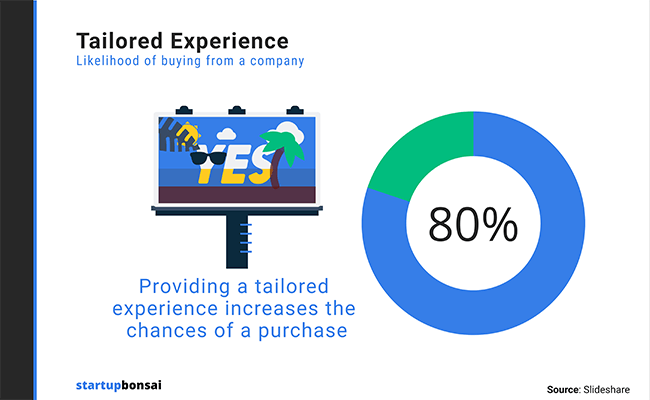
As this stat shows, if you’re not offering a tailored experience, you’re losing sales. (Slideshare)
66% of consumers expect brands to understand their individual needs
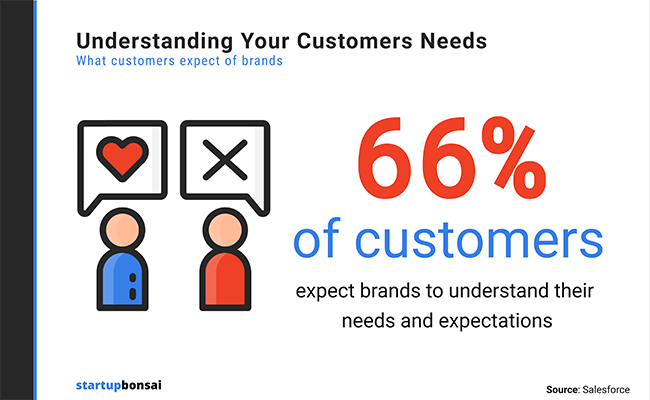
Understanding what your customers want is crucial to marketing personalization success. (Salesforce)
70% of consumers say that how well a company understands their individual needs impacts their loyalty
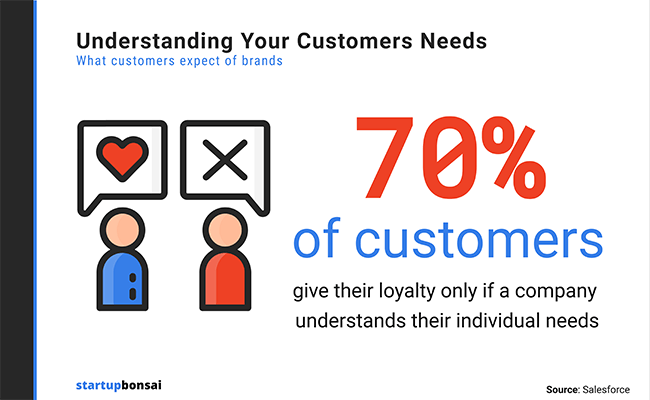
If brand loyalty is a goal, make sure you have a detailed understanding of your customers. (Salesforce)
71% of customers are frustrated by impersonal shopping experiences

Customers expect personalization when they’re shopping online, and are annoyed when brands fail to deliver it. (Segment)
42% of customers are frustrated by impersonalized content
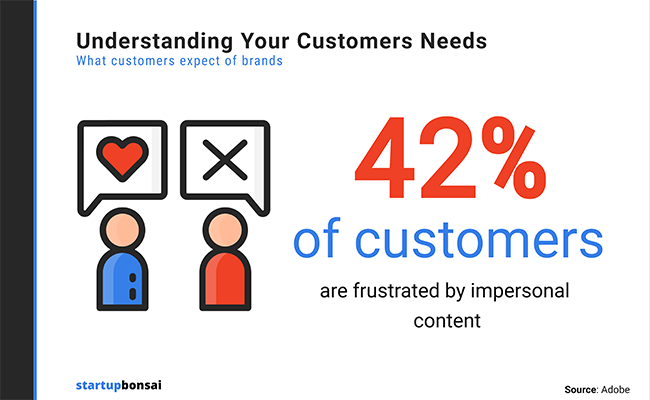
Content personalization isn’t as easy to implement as making product recommendations, but it is just as important. (Adobe)
90% of consumers in the US find the idea of personalization appealing
Despite privacy concerns, the vast majority of Americans are still on board with the idea of personalization. (Statista)
72% of customers will only engage with personalized messaging
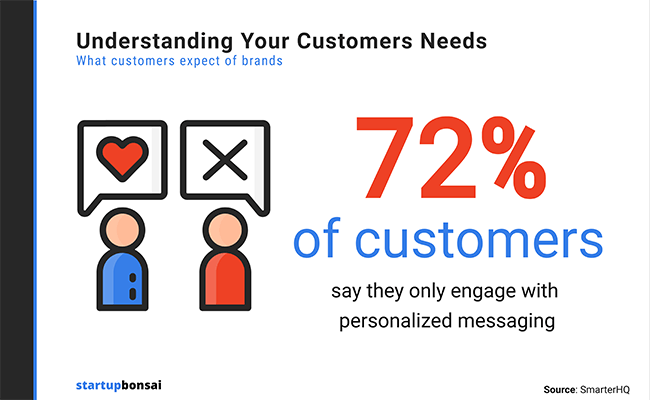
Personalizing your messaging is a surefire way to increase engagement. (SmarterHQ)
63% of consumers won’t buy from brands that have poor personalization
If it wasn’t already clear, personalization has a big impact on sales. (Smart Insights)
Marketing personalization adoption statistics
As you can see, consumers want personalized experiences – but how many businesses are delivering them? Here are some statistics that reveal how much of a priority personalization is to marketers and businesses around the world.
Almost 90% of online businesses already invest in personalization
The vast majority of digital businesses see the benefits of personalization. If you’re in the 10% that isn’t already investing in it, now’s the time to start. (Forrester)
60% of marketers say their digital content is extensively or very extensive personalized
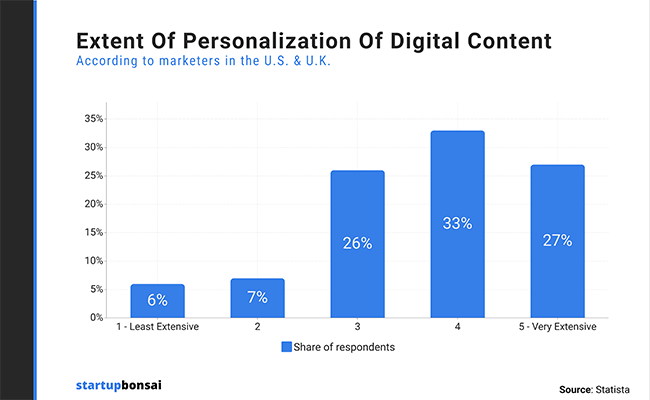
… which means 40% of marketers still think there’s room for improvement. (Statista)
51% of marketers rate personalization as their number 1 priority
Sending more behavioral-based messages was another top priority for marketers, according to the survey. (SmarterHQ)
79% of businesses in the retail sector invest in personalization tools
That’s more than any other industry and is perhaps an indication that retailers have the most to gain when it comes to personalization. (SmarterHQ)
88% of marketers say their biggest goal with personalization is to improve the customer experience
This makes a lot of sense. Personalization is first and foremost about providing great customer experiences. (Evergage)
Consumer personalization preferences
Next, let’s take a look at what good personalization looks like based on consumer preferences.
Around three-quarters of consumers find the idea of “living profiles” (very detailed customer profiles) valuable
…if they were used to provide a more personalized experience. (Accenture)
Consumers are more than twice as likely to view personalized offers as important than unimportant
…and 52% expect offers to always be personalized (Salesforce)
41% of consumers find receiving personalized texts from brands when they walk by a store to be creepy
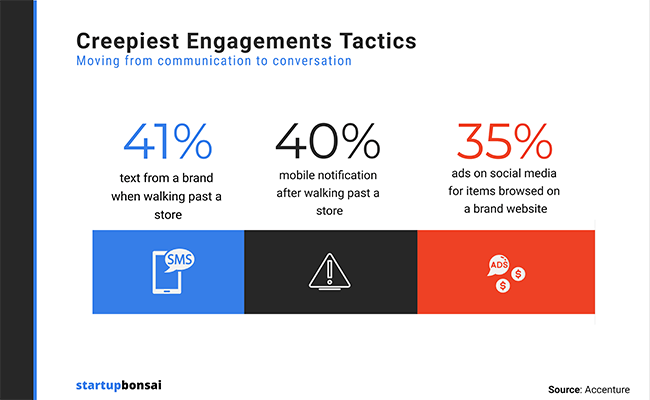
Customers don’t like the idea of brands knowing exactly where they are at any given time – and I don’t blame them! This level of personalization is seen as too invasive and is best avoided. (Accenture)
45% of consumers think the ‘coolest’ personalized engagement tactic is sending apology emails after poor customer experiences
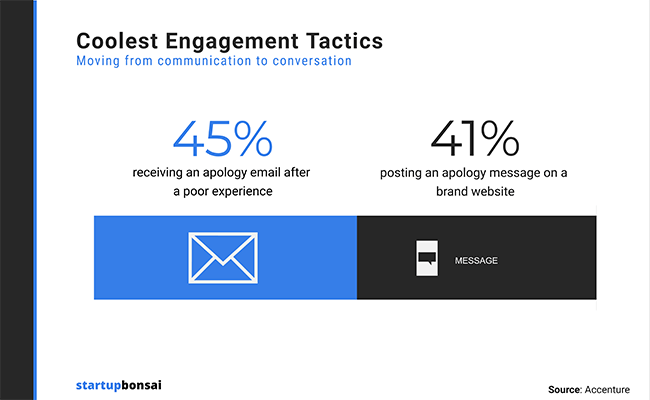
This is the overall ‘coolest’ personalization engagement tactic, according to the 2018 report. (Accenture)
70% of consumers are more likely to buy from company’s that understand how they use their products/services
Again, this shows just how important it is to know your customers. You have a wealth of data available about the way your customers interact with your products and services – make sure you’re using it! (Salesforce)
84% of customers say they’re more likely to buy from brands that treat them like a person, not a number
Unfortunately, brands still seem to be falling short of the mark in this regard, as 66% also say they’re generally treated like numbers. (Salesforce)
67% of consumers think it’s important for brands to automatically adjust their content to reflect the current context
Providing this kind of real-time personalized experience is a great way to please your customers.
This can be achieved easier than ever thanks to developments in marketing automation software. (Accenture)
90% of consumers are happy to share their data to receive exclusive discounts on products they’re interested in
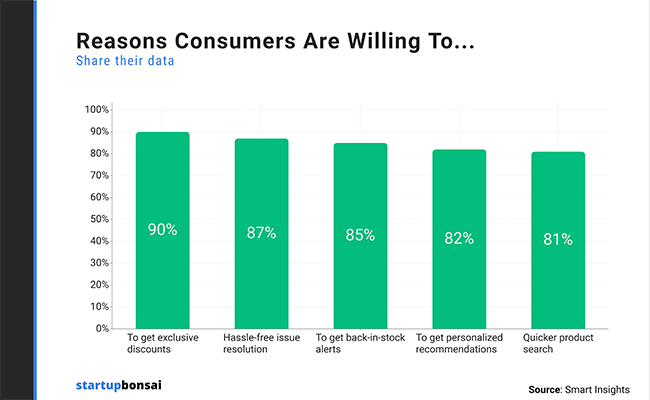
It seems that customers are willing to overlook some of their privacy concerns if it’ll save them money. (Smart Insights)
Personalization ROI statistics
One of the biggest questions marketing executives and business decision-makers want to know is how much of an impact investing in personalization will have on their bottom line. Here are some personalization ROI statistics that shed some light on that question.
Around 88% of marketers in the US saw measurable results from their marketing personalization efforts
… and 53% of those reported a lift of more than 10%. (Evergage)
Companies that use advanced personalization see returns of $20 per $1 spent
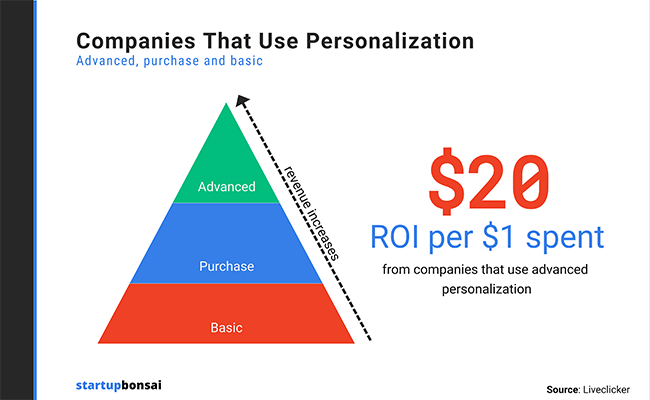
Yep, you read that right. That’s an ROI of 20:1. (Liveclicker)
79% of companies that exceed revenue goals have a documented personalization strategy
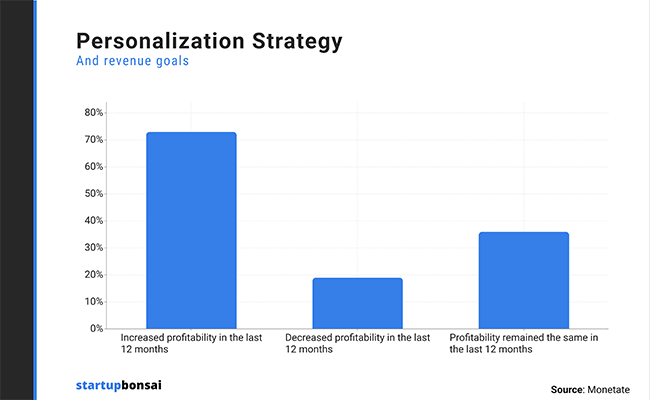
If you aren’t already, it may be worth documenting your personalization strategy. (monetate)
83% of companies that exceed revenue goals have a dedicated personalization budget
Budget constraints are one of the main reasons many companies aren’t yet investing in personalization but, as this stat shows, those that have the budget for it reap the rewards. (monetate)
Personalization reduces customer acquisition costs by as much as 50%
Personalization isn’t just about increasing revenue; it can also help to reduce costs. (ADWEEK)
Personalization increases marketing spend efficiency by as much as 30%
This increased efficiency is achieved predominantly through personalized product recommendations and triggered marketing communications. (McKinsey & Company)
According to 55% of marketers, the #1 benefit of personalization is better visitor engagement and customer experiences
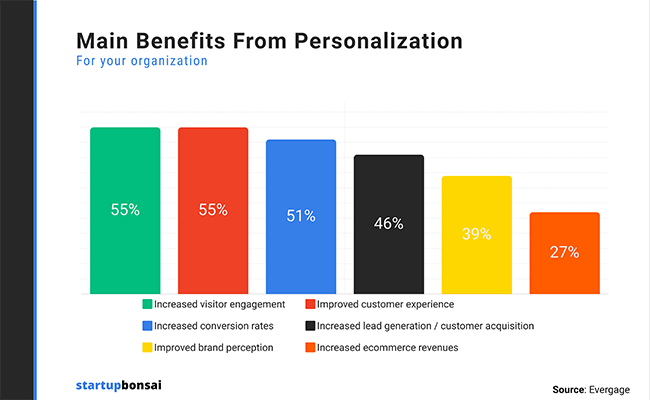
Not all of the returns on personalization are measurable in dollars – improving your customer experiences is one of them. (Evergage)
98% of marketers believe personalization helps to advance customer relationships
The vast majority of marketers feel personalization improves the customer-brand relationship. (Evergage)
Email marketing personalization statistics
One of the easiest marketing channels to start implementing personalization in is email. Most email marketing services offer some form of personalization.
Here are some key email marketing personalization stats you should know.
Marketers report a whopping 760% revenue increase from segmented email marketing campaigns
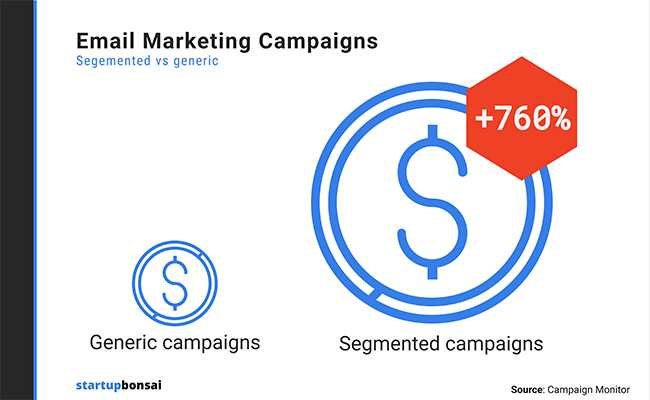
As this stat shows, it pays to personalize. (Campaign Monitor)
96% of company’s think personalization can improve email marketing performance
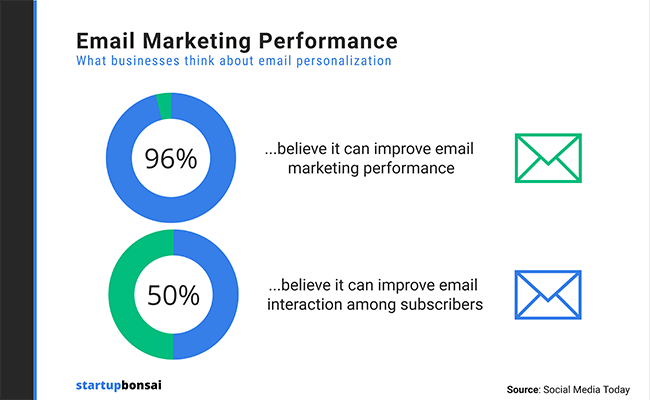
… and they’re probably right! (SocialMediaToday)
70% of millennials find irrelevant emails from brands frustrating
As a millennial, I concur. If you don’t want to be relegated to the spam folder, it’s important to make sure you’re sending out relevant emails your customers are interested in. (SmarterHQ)
Half of all marketers say email segmentation is the most effective personalization strategy
Segmentation is a powerful personalization tactic that involves dividing your list into subscribers based on your subscriber’s geographical data, interests, purchase history, site activity, and other personal data. (Instapage)
Including personalized subject lines in your emails improves open rates by 26%
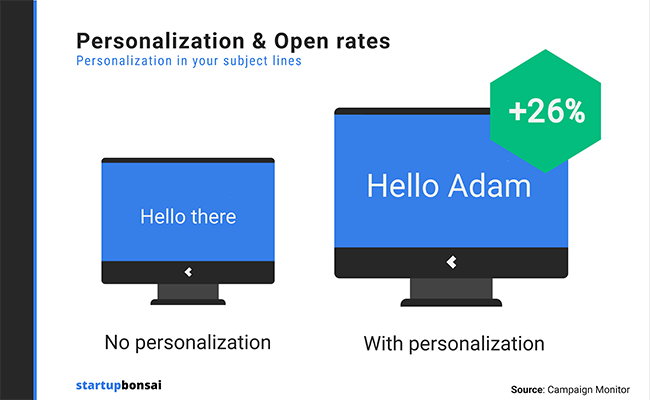
One of the easiest ways to increase open rates is to simply include the recipient’s name in the email subject line. That little touch of personalization can make a big difference. (Campaign Monitor)
75% of marketers think personalization improves click-through rates
It’s not just open rates – personalization increases CTR too. (SocialMediaToday)
Personalized emails drive 6x more transactions
… compared to non-personalized email campaigns. (SocialMediaToday)
55% of consumers think receiving targeted promotional offers would improve their email experience
If it wasn’t already clear, customers like email personalization – especially when it involves targeted discounts and offers. (Dynamic Yield Research)
52% of consumers will look elsewhere if an email isn’t personalized
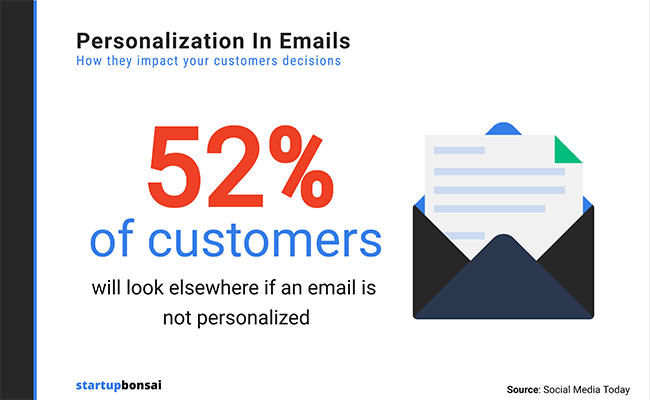
To avoid losing customers, companies should anticipate customer needs and personalize their emails with personalized content and product offers. (SocialMediaToday)
Personalized CTAs convert 202% better than non-personalized CTAs
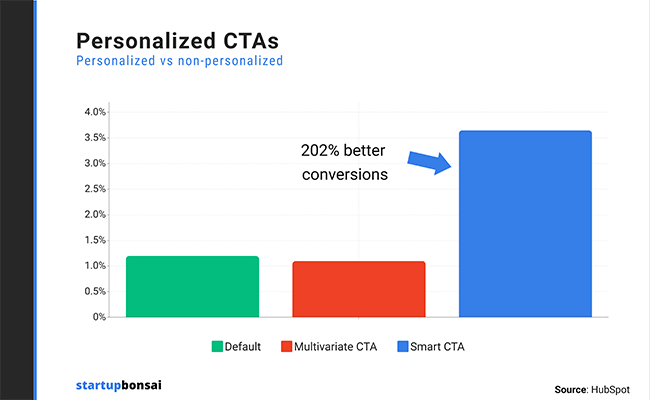
If you include a call-to-action in your email, make sure it’s personalized and you might just see more conversions. (HubSpot)
70% of brands don’t use personalized email messages
Despite the clear benefits of personalized email marketing, the majority of brands are still failing to implement it. (MARTECH)
Advertising personalization statistics
Below are some statistics that reveal interesting insights about personalization in digital advertising.
40.5% of consumers would prefer to see ads targeted to their interests
Delivering relevant ads to consumers that are actually interested in what you’re selling improves the customer experience. (GrenisMedia)
Retargeted ads generate 10x better CTRs than display ads
Unsurprisingly, ads that are delivered to customers who’ve already interacted with your business dramatically outperform traditional display ads. (ReadyCloud)
35% of consumers find retargeting ads on social sites for items they’ve browsed on a website creepy
Unfortunately, while retargeting ads are undoubtedly effective, many customers find them disconcerting and invasive. (Accenture)
Transparency in targeted advertising can increase revenue by 38%
This is based on a study from Harvard Business Review, in which targeted ads were delivered to customers alongside a message disclosing that the ads were based on their on-site activity to aid with transparency. This disclosure increased both click-through rates and product sales. (Harvard Business Review)
Personalized website and content statistics
Here are some statistics that reveal why you might want to personalize your website content.
74% of consumers are frustrated by website content that isn’t personalized
Personalizing your website content to your website users is important if you want to keep your customers happy. (Instapage)
Note: If you want to learn how to create a website that your users will love, be sure to check out our article on user experience stats.
Personalized promotions on website homepages influences 85% of customers to make a purchase
This is according to a 2017 Kibo Consumer Trends report. The upshot: personalize your homepage promotions to help your customer’s out on their path to purchase. (businesswire)
Marketers who personalize web experiences see an average 19% uplift in sales
Taking the time to plan and implement personalized web experiences for your customers pays off in increased sales and revenue. (Instapage)
Poor content relevancy in marketing campaigns leads to 83% lower response rates on average
When it comes to content, relevancy is key. Producing relevant content your customers want to read leads to greater engagement. (Instapage)
Ecommerce personalization statistics
Should you be providing personalized ecommerce shopping experiences to your customers? As the statistics below show, the answer is probably yes!
Personalized shopping cart product recommendations influences 92% of customers to make a purchase
With so many third-party shopping cart plugins out there, offering personalized product recommendations has never been easier. And as this stat shows, it can have a big impact on your sales figures. (Instapage)
56% of all online shoppers are more likely to go back to a website with product recommendations
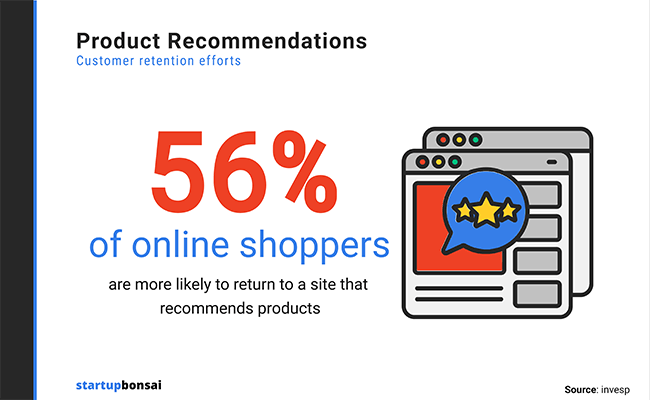
Product recommendations also help with your customer retention efforts. You can use your sales receipt emails to recommend further products and drive traffic back to your website. (invesp)
44% of customers that experience personalized shopping experiences say they’ll become repeat buyers
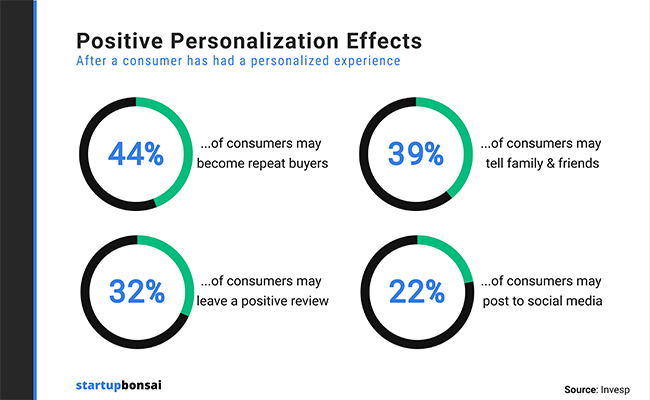
…and repeat business means more revenue. (invesp)
47% of consumers will go to Amazon if the online retailer they’re shopping with doesn’t offer relevant product suggestions
Amazon is the biggest competitor in the online retail space. If you want to continue to compete with them, make sure you’re offering relevant product suggestions. (SmarterHQ)
31% of consumers want their shopping experience to be far more personalized
As this personalization statistic shows, ecommerce businesses are still not meeting customers’ expectations when it comes to personalization. There’s still a lot of room for improvement. (Instapage)
Personalization challenges
Despite the increasing adoption of personalized marketing strategies, there are still some challenges marketers need to overcome. Here are a handful of statistics that show the main barriers to personalization
58% of consumers say brands send them items that they don’t want
As this statistic shows, many companies clearly still don’t know what their customers want well enough to provide proper personalized communications. (SmarterHQ)
38% of customers want personalization but don’t want to share too much data
Providing personalized data starts with gathering data on your customers to better understand their needs. However, customers aren’t comfortable with divulging too much personal information about them. This presents a challenge for brands who must walk a fine line in order to balance personalization with privacy. (Retail TouchPoints)
28% of consumers don’t like it when brands have their information if they haven’t explicitly provided it
This shows the importance of transparency in data collection. (Instapage)
Wrapping it up
That wraps up our roundup of the latest marketing personalization statistics, facts, and trends.
Whether you should use personalized marketing depends on your business. Use these statistics to make the right decision for your business.
The good news is that more B2B software platforms are beginning to incorporate personalization functionality. For example, you’ll typically find these kind of features within marketing automation software, ecommerce store builders, and landing page software.
What’s next? We’ve got plenty more data-driven content for you to check out:
